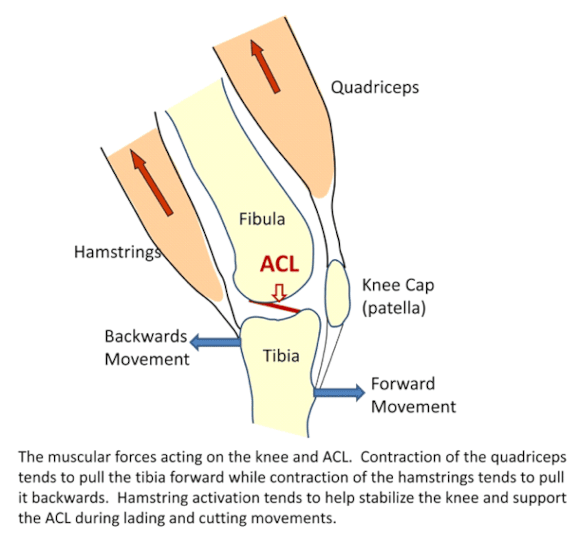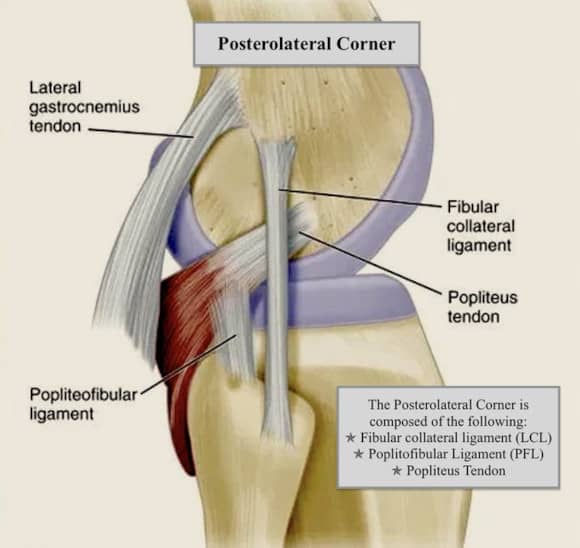
The ACL is the primary restraint to anterior tibial translation and also plays a role in rotary stability.
It is composed of two bundles, named based on their tibial insertions:
✯ Anteromedial
✯ Posterolateral
Anteromedial bundle:
✯ Tightest in Flexion
✯ Resists anterior tibial translation
✯ Tested by Lachman's/Anterior Drawer
Posterolateral bundle:
✯ Tightest in Extension
✯ Rotatory Restraint
✯ Tested by Pivot Shift

ACL injuries occur more frequently in female athletes, potential reasons include:
✯ Having a smaller femoral notch
✯ Ligamentous laxity
✯ Suboptimal neuromuscular firing patterns when landing/decelerating commonly termed quadricep dominance.
The term quadricep dominance gets thrown around but rarely gets explained.
When decelerating or landing stress is placed upon the ACL as the tibia will want to translate anteriorly. The hamstrings can help prevent stress on the ACL by activating and resisting anterior tibial translation.
In someone who has suboptimal neuromuscular firing patterns the quadricep is more dominant than the hamstrings when landing/decelerating. These athletes not only lose some of the protective effects of hamstring contraction but may increase the stress on the ACL with increased quadriceps contraction.
In essence the hamstring is an ally of the ACL, and the quadriceps is an antagonist when decelerating/landing.

The majority of ACL injuries, around 70%, are due to non-contact injuries (pivoting/deceleration).
Of note: nearly half of ACL tears are associated with lateral meniscus tears.
Concomitant posterolateral corner injuries may occur and lead to an increased risk of graft failure.

Patients will present with knee pain, difficulty weight-bearing, and they may report hearing a "pop".
Up to ¾ of patients will present with a joint effusion from hemarthrosis.
Provocative Tests:
✯ Anterior Drawer Test
-Assesses ant. tibial translation at 90° flexion with the foot fixed
✯ Lachman Test
-Assesses ant. tibial translation at 30° flexion
✯ Pivot Shift
-Explained below.
Lachman's test has been noted to be the most sensitive.

Knee radiographs may be obtained along with an MRI if ACL injury is suspected.
Additional radiographic signs of ACL injury:
✯ Segond fractures (shown below) are highly associated with ACL tears
✯ Bruising of the lateral femoral condyle and tibial plateau may be seen on MRI

Non-operative treatment with physical therapy may be trialed in low demand patients though it may place the patient at an increased risk of chondral damage and meniscal injury.
Most active patients require ACL reconstruction.
ACL repair is a rare practice due to high failure rates.
Grafts may be autograft (from the patient) or allograft (cadaver).
Graft options include bone-patellar tendon-bone (BPTB), quadriceps tendon, and hamstring tendon.
Graft choice should come from a discussion between the patient and surgeon.

Bone-patellar tendon-bone graft is unique in that it allows the potential for bone-to-bone healing.
Anterior knee pain following BPTB grafting has been reported and there is an increased risk of patellar fracture, particularly during the rehab period.
Grafts are commonly single bundle.
Double bundle grafts were introduced with the idea of being biomechanically stronger and were aimed at producing a more anatomic graft but have not shown clinically significant differences and are at an increased risk of graft impingement.
A 2015 study by Wasserstein et al. showed a 2.6x higher rate of graft failure among patients < 25 y.o. treated with allograft vs. autograft.
In general, patients < 25 y.o. should utilize autograft.
A concern when performing ACL reconstructions is the orientation of the graft.
If the graft is placed too vertical, it will lead to:
✯ Restoration of sagittal stability
✯ Limited effect on rotatory stability
✯ Increased risk of graft failure.

Following ACL reconstruction, the main goals are to prevent joint effusion, avoid placing stress onto the graft, and achieve full passive knee extension.
Early progression to weight-bearing has been shown to reduce patellofemoral pain and decrease quadriceps inhibition.
References:
1: https://pubmed.ncbi.nlm.nih.gov/28966380/
2: https://www.ncbi.nlm.nih.gov/books/NBK559233/
3: https://pubmed.ncbi.nlm.nih.gov/27053841/
4: https://pubmed.ncbi.nlm.nih.gov/26131297/
5: https://pubmed.ncbi.nlm.nih.gov/28791612/